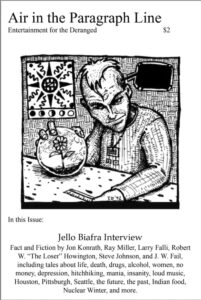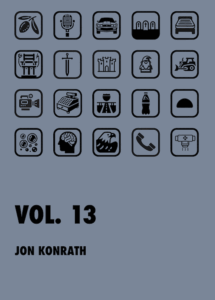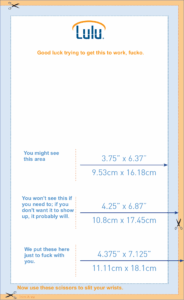 I’ve been slowly working on what to do about the Paragraph Line web site and social media and whatnot, as both me and John have been releasing books and have no idea how to sell them. Anyway, I did a quick reboot of the web site, and it’s live again at http://paragraphline.com/. It’s currently an incredibly rough static site, just so if someone sees the link on a book cover or whatever and clicks it, they get something.
I’ve been slowly working on what to do about the Paragraph Line web site and social media and whatnot, as both me and John have been releasing books and have no idea how to sell them. Anyway, I did a quick reboot of the web site, and it’s live again at http://paragraphline.com/. It’s currently an incredibly rough static site, just so if someone sees the link on a book cover or whatever and clicks it, they get something.
None of the blog is there, so none of the fiction we published about ten years ago is there. I still have this stuff stashed away, and I’ve thought about republishing it, starting up the slush queue again, and going back to daily blogging, releasing other flash fiction, and that whole thing. Ultimately, that had an incredibly low ROI, and I wasted a lot of time for very little traffic. I got a lot of submissions from people who obviously never looked at the site whatsoever. I also got a lot of traffic from people who had Bizarro-related fiction who couldn’t get it placed at any official Bizarro outlet, so lots of second-rate stuff. There were exceptions, but I did not like spending all my time sifting through the queue, begging people to read the damn thing, and screaming into the void. Faced with that versus actually writing, I chose the latter.
Aside from the content generation and the general algorithm issues, I struggled with tooling. WordPress is basically a virus vector disguised as a CMS, and the “you can do anything with WordPress” people are all designers charging an obscene amount for development. I tried firing up a Ghost instance in AWS and moving everything there, and it didn’t really work well. I also recently tried pulling it into Hugo, and it was a bit of a disaster. I finally gave up and used a static template, which looks okay, but blogging there is not going to be a thing at all.
Social media-wise, I have no idea what to use. I’m absolutely not using Twitter. I think all Meta platforms are impossible to get any reach. All the kids are using Bluesky now, so I just created a profile @paragraphline and maybe someday someone will follow it. This all falls firmly into “I have no time for this” and I’m trying to get the next book done, so it won’t happen in the immediate future.
* * *
Related: John has re-released three of his books in one volume; check out After the Jump: A Trilogy. And I’ve still got my book from December you should check out, Decision Paralysis.
* * *
One of the things that came to mind as I was assembling this books page was the large number of books I have that are now out of print. This was intentional for a few reasons, but I fret over what I should do about this. It’s not as easy as “well just re-list them” because, well, it isn’t.
I currently have 18 books that were published at one point, and four of them are currently for sale. I think the short answer here is a combination of the fact that I am really proud of the four that are currently out, and four is more than zero, so at least there’s that. But when I think about reissuing the others, there are a few things stopping me.
First, there are quality issues. I get unending shit about “you need to hire an editor” which always bothers me. In one sense, it’s like telling Iggy Pop he needs to re-record Raw Power with autotune, because some of the notes aren’t hit perfectly. Also, I’m not going to pay hundreds or thousands of dollars to an editor on a book that’s going to sell 14 copies with a profit margin of like 29 cents a copy. That said, I find typos in these old books, and if I’m going to reissue them, I at least want to sweep through them and fix things.
And the problem with pulling that thread at the edge of the sweater is I will quash typos, but along the way I’ll find paragraphs that are uneven or places I wish I’d expanded or stories that didn’t end right or… whatever. There’s an argument for changing things significantly in a new reissue. Like William Burroughs published three very different versions of The Soft Machine in his lifetime (and a fourth posthumously) and he had no problems ripping out half the book, adding back as many new pages, and rearranging the whole thing. Part of me thinks doing that would be fun. Part of me thinks it’s a bit too George Lucas. And either way, this would require a lot of time I don’t have.
I think there’s also the issue of me having past work I’m not proud of. Sometimes I go back into an old book and find it’s aged well, and parts are still funny or well-written. But there are times I look at some stuff like the trilogy of flash books (Earworm, Sleep, Thunderbird) and I feel like maybe 50% of it is solid, and the rest is plain embarrassing. (The two zine-book things, Help… and Ranch are similar. And I reread He recently and it’s absolutely horrible.) There’s a lot of gonzo writing that’s largely scatological and stupid, and I feel the people who are fans of that aspect of my old writing, that persona I used, will never get what I’m trying to do now. And it’s definitely not stuff I want coworkers or potential employers to read. A lot of it would straight up get me cancelled at this point. I don’t want to write like this anymore, and spending time reintroducing stuff that I’m actually ashamed of now is a fool’s errand. Maybe I could do a “greatest hits” with just some of this stuff picked out. Once again, that’s a lot of time invested that could be used on writing new books.
There are books that are simply too far off my path to even deal with. Memory Hunter was a fun experiment and I loved doing it. The writing maybe 80% holds up. But nobody got the joke, and those of my fans who did read it all said it was good but not Konrath enough. Summer Rain is tough, because it was my first book and it meant a lot to me. And its fans are into that heavy 90s nostalgia, but I absolutely do not want to work in that genre anymore. Nostalgia is pain, and it doesn’t help that 40% of the country is actively destroying this country trying to go back to a time that never existed because of their delusions about the past. The Necrokonicon falls into that category, too. The Vegas book and the journal book that nobody read were both quickie get-something-out experiments that failed.
That leaves Rumored and Atmospheres. Spoiler alert: both of those have sequels that are well underway. So there may be a tie-in rerelease of either or both, but there’s a combination of all of the above problems with them. Like I’ve been rereading Atmospheres a lot recently and there are some absolutely solid riffs in there that I love. And then there’s some borderline sexist diatribe or embarrassing scatalogical bit that does nothing for the story and is just “look at me! I’m crazy!” writing. I’ve actually paid an editor to proof both of those books and search out the typos, but I don’t know what to do about questionable content.
And case in point on all of this: I reissued Vol. 13 last fall. I did a quick editing pass, changed the ebook layout, and redesigned the cover. I don’t know how many hours I spent on the project, but it was not a quick job. Since then it has sold five copies. I make about two bucks a book. So the “you could just pay someone else to do it for you” argument sort of falls flat, as I’d probably sink a few hundred bucks into it and get back ten of it. And I’d be rolling the dice on getting a layout I’d actually like.
Bottom line: I’m writing a lot right now, and that’s the focus. So, more of that, right?




